Attached files
| file | filename |
|---|---|
| 8-K - 8-K - PennyMac Mortgage Investment Trust | d890126d8k.htm |
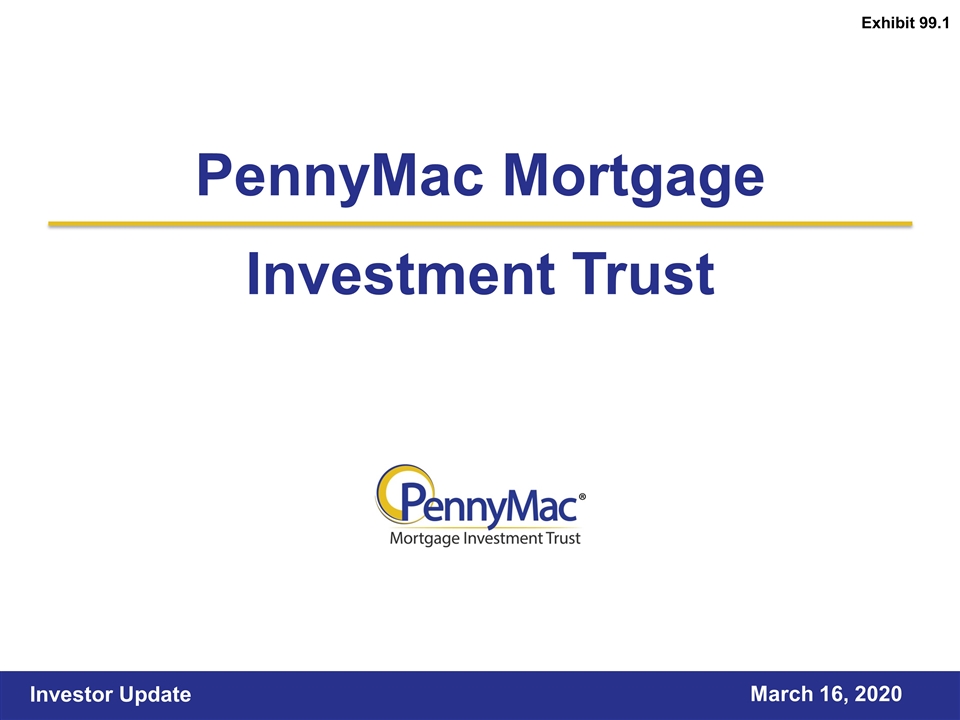
PennyMac Mortgage Investment Trust March 16, 2020 Investor Update Exhibit 99.1
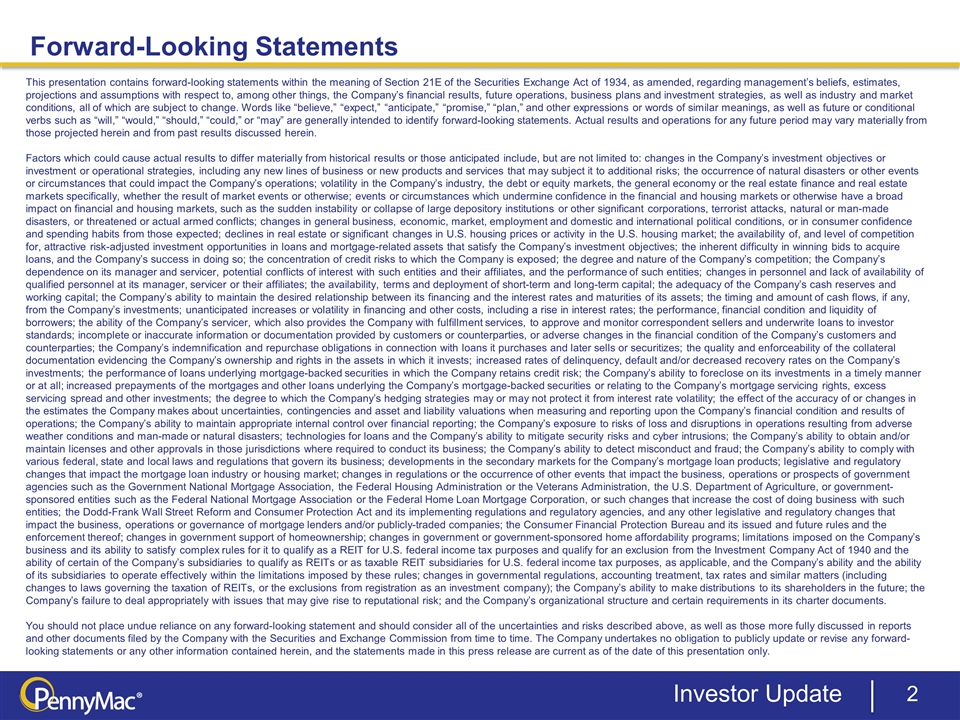
Forward-Looking Statements This presentation contains forward-looking statements within the meaning of Section 21E of the Securities Exchange Act of 1934, as amended, regarding management’s beliefs, estimates, projections and assumptions with respect to, among other things, the Company’s financial results, future operations, business plans and investment strategies, as well as industry and market conditions, all of which are subject to change. Words like “believe,” “expect,” “anticipate,” “promise,” “plan,” and other expressions or words of similar meanings, as well as future or conditional verbs such as “will,” “would,” “should,” “could,” or “may” are generally intended to identify forward-looking statements. Actual results and operations for any future period may vary materially from those projected herein and from past results discussed herein. Factors which could cause actual results to differ materially from historical results or those anticipated include, but are not limited to: changes in the Company’s investment objectives or investment or operational strategies, including any new lines of business or new products and services that may subject it to additional risks; the occurrence of natural disasters or other events or circumstances that could impact the Company’s operations; volatility in the Company’s industry, the debt or equity markets, the general economy or the real estate finance and real estate markets specifically, whether the result of market events or otherwise; events or circumstances which undermine confidence in the financial and housing markets or otherwise have a broad impact on financial and housing markets, such as the sudden instability or collapse of large depository institutions or other significant corporations, terrorist attacks, natural or man-made disasters, or threatened or actual armed conflicts; changes in general business, economic, market, employment and domestic and international political conditions, or in consumer confidence and spending habits from those expected; declines in real estate or significant changes in U.S. housing prices or activity in the U.S. housing market; the availability of, and level of competition for, attractive risk-adjusted investment opportunities in loans and mortgage-related assets that satisfy the Company’s investment objectives; the inherent difficulty in winning bids to acquire loans, and the Company’s success in doing so; the concentration of credit risks to which the Company is exposed; the degree and nature of the Company’s competition; the Company’s dependence on its manager and servicer, potential conflicts of interest with such entities and their affiliates, and the performance of such entities; changes in personnel and lack of availability of qualified personnel at its manager, servicer or their affiliates; the availability, terms and deployment of short-term and long-term capital; the adequacy of the Company’s cash reserves and working capital; the Company’s ability to maintain the desired relationship between its financing and the interest rates and maturities of its assets; the timing and amount of cash flows, if any, from the Company’s investments; unanticipated increases or volatility in financing and other costs, including a rise in interest rates; the performance, financial condition and liquidity of borrowers; the ability of the Company’s servicer, which also provides the Company with fulfillment services, to approve and monitor correspondent sellers and underwrite loans to investor standards; incomplete or inaccurate information or documentation provided by customers or counterparties, or adverse changes in the financial condition of the Company’s customers and counterparties; the Company’s indemnification and repurchase obligations in connection with loans it purchases and later sells or securitizes; the quality and enforceability of the collateral documentation evidencing the Company’s ownership and rights in the assets in which it invests; increased rates of delinquency, default and/or decreased recovery rates on the Company’s investments; the performance of loans underlying mortgage-backed securities in which the Company retains credit risk; the Company’s ability to foreclose on its investments in a timely manner or at all; increased prepayments of the mortgages and other loans underlying the Company’s mortgage-backed securities or relating to the Company’s mortgage servicing rights, excess servicing spread and other investments; the degree to which the Company’s hedging strategies may or may not protect it from interest rate volatility; the effect of the accuracy of or changes in the estimates the Company makes about uncertainties, contingencies and asset and liability valuations when measuring and reporting upon the Company’s financial condition and results of operations; the Company’s ability to maintain appropriate internal control over financial reporting; the Company’s exposure to risks of loss and disruptions in operations resulting from adverse weather conditions and man-made or natural disasters; technologies for loans and the Company’s ability to mitigate security risks and cyber intrusions; the Company’s ability to obtain and/or maintain licenses and other approvals in those jurisdictions where required to conduct its business; the Company’s ability to detect misconduct and fraud; the Company’s ability to comply with various federal, state and local laws and regulations that govern its business; developments in the secondary markets for the Company’s mortgage loan products; legislative and regulatory changes that impact the mortgage loan industry or housing market; changes in regulations or the occurrence of other events that impact the business, operations or prospects of government agencies such as the Government National Mortgage Association, the Federal Housing Administration or the Veterans Administration, the U.S. Department of Agriculture, or government-sponsored entities such as the Federal National Mortgage Association or the Federal Home Loan Mortgage Corporation, or such changes that increase the cost of doing business with such entities; the Dodd-Frank Wall Street Reform and Consumer Protection Act and its implementing regulations and regulatory agencies, and any other legislative and regulatory changes that impact the business, operations or governance of mortgage lenders and/or publicly-traded companies; the Consumer Financial Protection Bureau and its issued and future rules and the enforcement thereof; changes in government support of homeownership; changes in government or government-sponsored home affordability programs; limitations imposed on the Company’s business and its ability to satisfy complex rules for it to qualify as a REIT for U.S. federal income tax purposes and qualify for an exclusion from the Investment Company Act of 1940 and the ability of certain of the Company’s subsidiaries to qualify as REITs or as taxable REIT subsidiaries for U.S. federal income tax purposes, as applicable, and the Company’s ability and the ability of its subsidiaries to operate effectively within the limitations imposed by these rules; changes in governmental regulations, accounting treatment, tax rates and similar matters (including changes to laws governing the taxation of REITs, or the exclusions from registration as an investment company); the Company’s ability to make distributions to its shareholders in the future; the Company’s failure to deal appropriately with issues that may give rise to reputational risk; and the Company’s organizational structure and certain requirements in its charter documents. You should not place undue reliance on any forward-looking statement and should consider all of the uncertainties and risks described above, as well as those more fully discussed in reports and other documents filed by the Company with the Securities and Exchange Commission from time to time. The Company undertakes no obligation to publicly update or revise any forward-looking statements or any other information contained herein, and the statements made in this press release are current as of the date of this presentation only. Investor Update
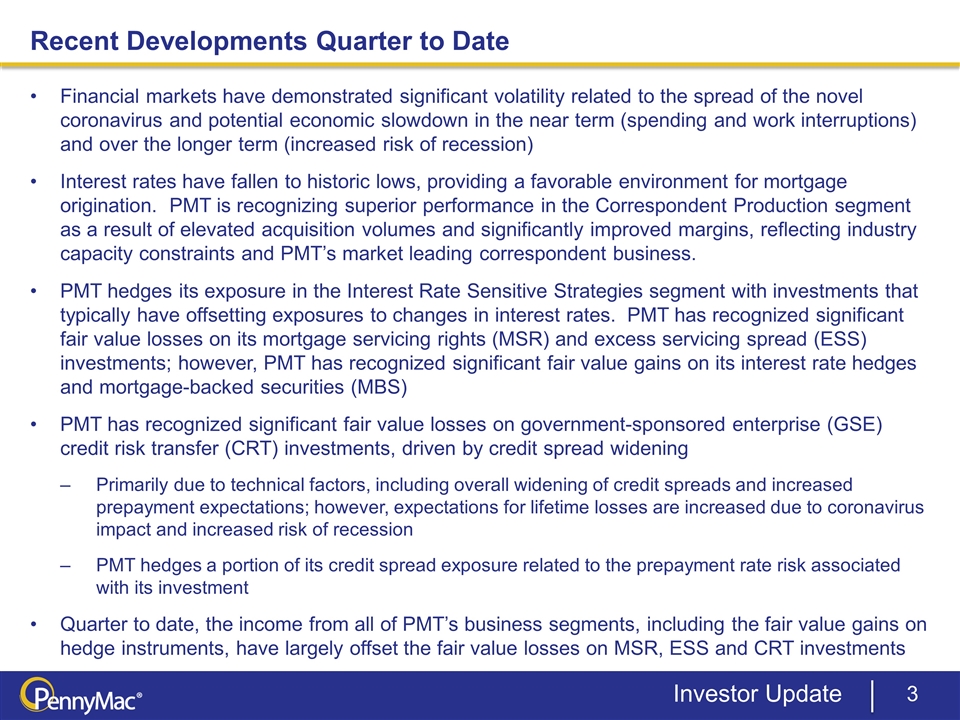
Recent Developments Quarter to Date Investor Update Financial markets have demonstrated significant volatility related to the spread of the novel coronavirus and potential economic slowdown in the near term (spending and work interruptions) and over the longer term (increased risk of recession) Interest rates have fallen to historic lows, providing a favorable environment for mortgage origination. PMT is recognizing superior performance in the Correspondent Production segment as a result of elevated acquisition volumes and significantly improved margins, reflecting industry capacity constraints and PMT’s market leading correspondent business. PMT hedges its exposure in the Interest Rate Sensitive Strategies segment with investments that typically have offsetting exposures to changes in interest rates. PMT has recognized significant fair value losses on its mortgage servicing rights (MSR) and excess servicing spread (ESS) investments; however, PMT has recognized significant fair value gains on its interest rate hedges and mortgage-backed securities (MBS) PMT has recognized significant fair value losses on government-sponsored enterprise (GSE) credit risk transfer (CRT) investments, driven by credit spread widening Primarily due to technical factors, including overall widening of credit spreads and increased prepayment expectations; however, expectations for lifetime losses are increased due to coronavirus impact and increased risk of recession PMT hedges a portion of its credit spread exposure related to the prepayment rate risk associated with its investment Quarter to date, the income from all of PMT’s business segments, including the fair value gains on hedge instruments, have largely offset the fair value losses on MSR, ESS and CRT investments
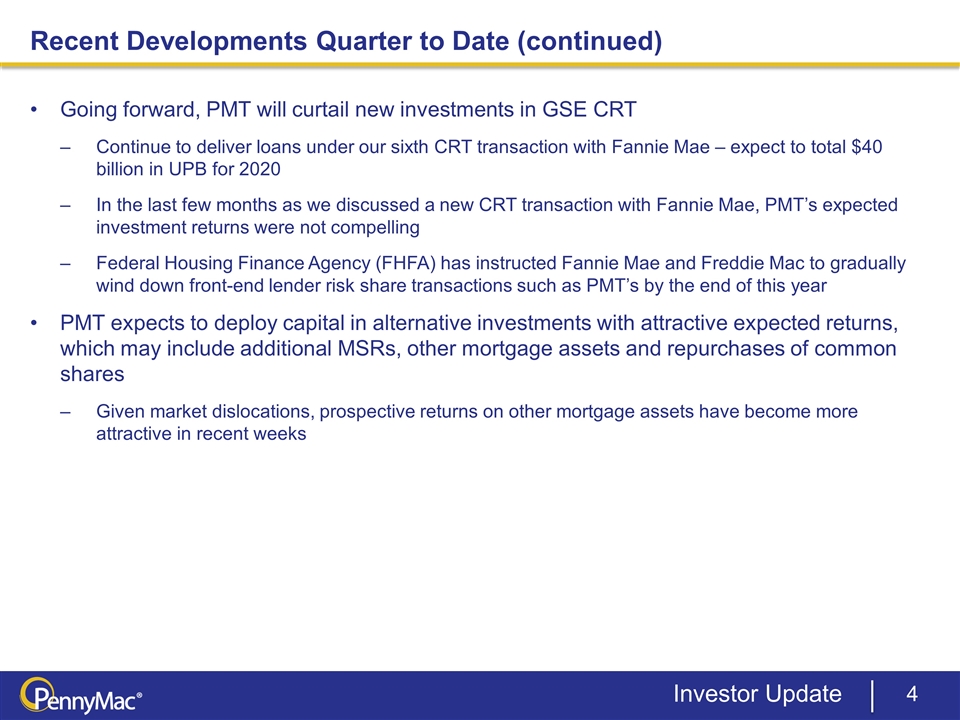
Recent Developments Quarter to Date (continued) Investor Update Going forward, PMT will curtail new investments in GSE CRT Continue to deliver loans under our sixth CRT transaction with Fannie Mae – expect to total $40 billion in UPB for 2020 In the last few months as we discussed a new CRT transaction with Fannie Mae, PMT’s expected investment returns were not compelling Federal Housing Finance Agency (FHFA) has instructed Fannie Mae and Freddie Mac to gradually wind down front-end lender risk share transactions such as PMT’s by the end of this year PMT expects to deploy capital in alternative investments with attractive expected returns, which may include additional MSRs, other mortgage assets and repurchases of common shares Given market dislocations, prospective returns on other mortgage assets have become more attractive in recent weeks
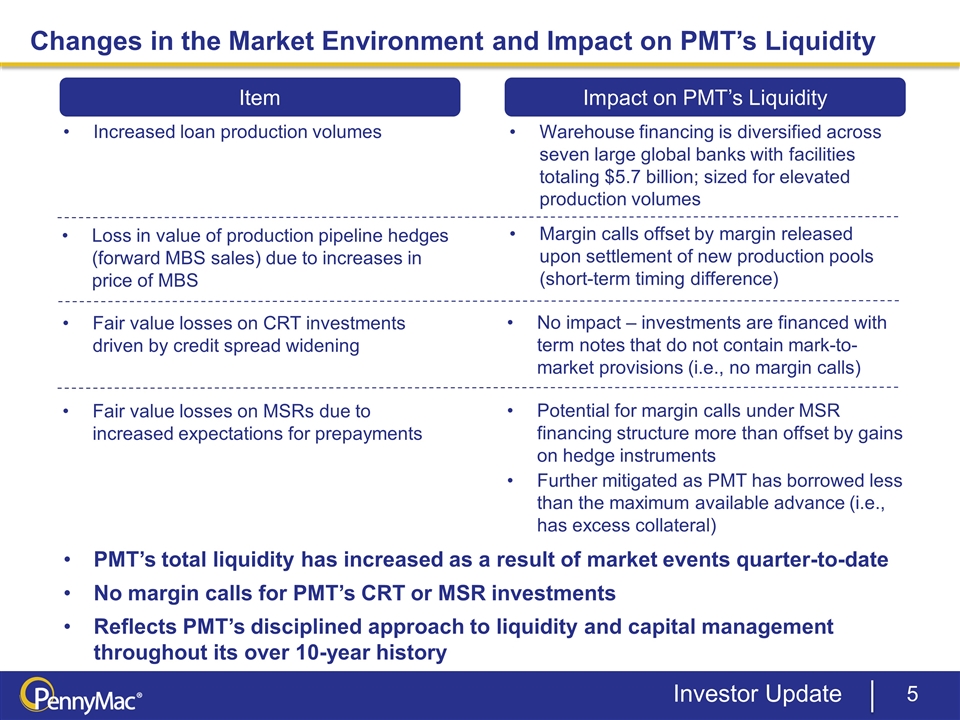
Changes in the Market Environment and Impact on PMT’s Liquidity Investor Update Item Impact on PMT’s Liquidity Fair value losses on CRT investments driven by credit spread widening No impact – investments are financed with term notes that do not contain mark-to-market provisions (i.e., no margin calls) Fair value losses on MSRs due to increased expectations for prepayments Potential for margin calls under MSR financing structure more than offset by gains on hedge instruments Further mitigated as PMT has borrowed less than the maximum available advance (i.e., has excess collateral) Increased loan production volumes Warehouse financing is diversified across seven large global banks with facilities totaling $5.7 billion; sized for elevated production volumes Loss in value of production pipeline hedges (forward MBS sales) due to increases in price of MBS Margin calls offset by margin released upon settlement of new production pools (short-term timing difference) PMT’s total liquidity has increased as a result of market events quarter-to-date No margin calls for PMT’s CRT or MSR investments Reflects PMT’s disciplined approach to liquidity and capital management throughout its over 10-year history
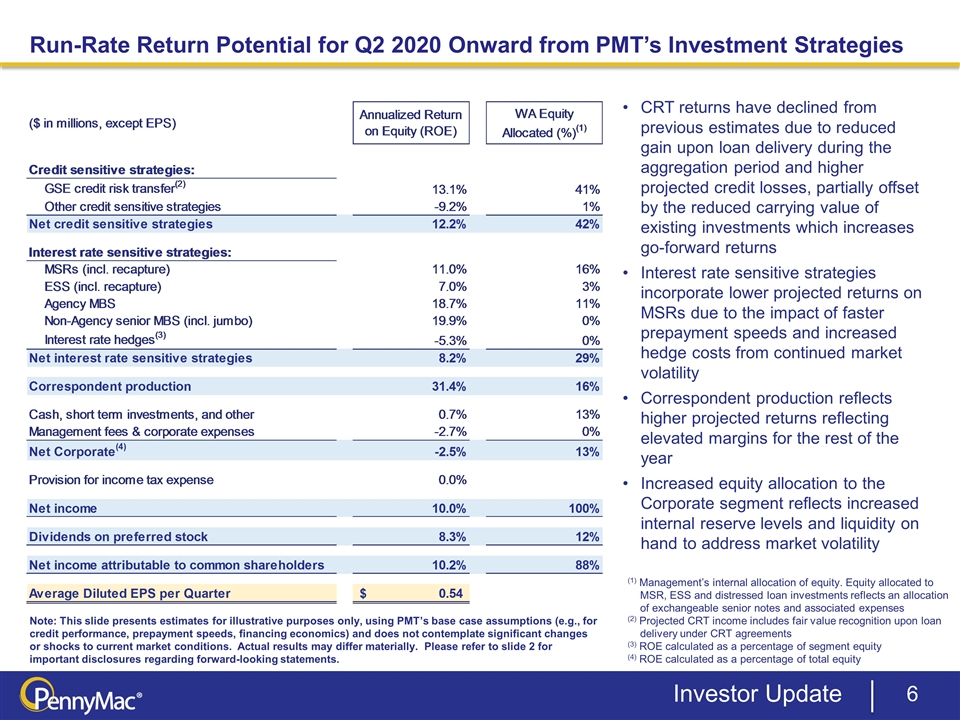
Investor Update Note: This slide presents estimates for illustrative purposes only, using PMT’s base case assumptions (e.g., for credit performance, prepayment speeds, financing economics) and does not contemplate significant changes or shocks to current market conditions. Actual results may differ materially. Please refer to slide 2 for important disclosures regarding forward-looking statements. (1) Management’s internal allocation of equity. Equity allocated to MSR, ESS and distressed loan investments reflects an allocation of exchangeable senior notes and associated expenses (2) Projected CRT income includes fair value recognition upon loan delivery under CRT agreements (3) ROE calculated as a percentage of segment equity (4) ROE calculated as a percentage of total equity Run-Rate Return Potential for Q2 2020 Onward from PMT’s Investment Strategies CRT returns have declined from previous estimates due to reduced gain upon loan delivery during the aggregation period and higher projected credit losses, partially offset by the reduced carrying value of existing investments which increases go-forward returns Interest rate sensitive strategies incorporate lower projected returns on MSRs due to the impact of faster prepayment speeds and increased hedge costs from continued market volatility Correspondent production reflects higher projected returns reflecting elevated margins for the rest of the year Increased equity allocation to the Corporate segment reflects increased internal reserve levels and liquidity on hand to address market volatility
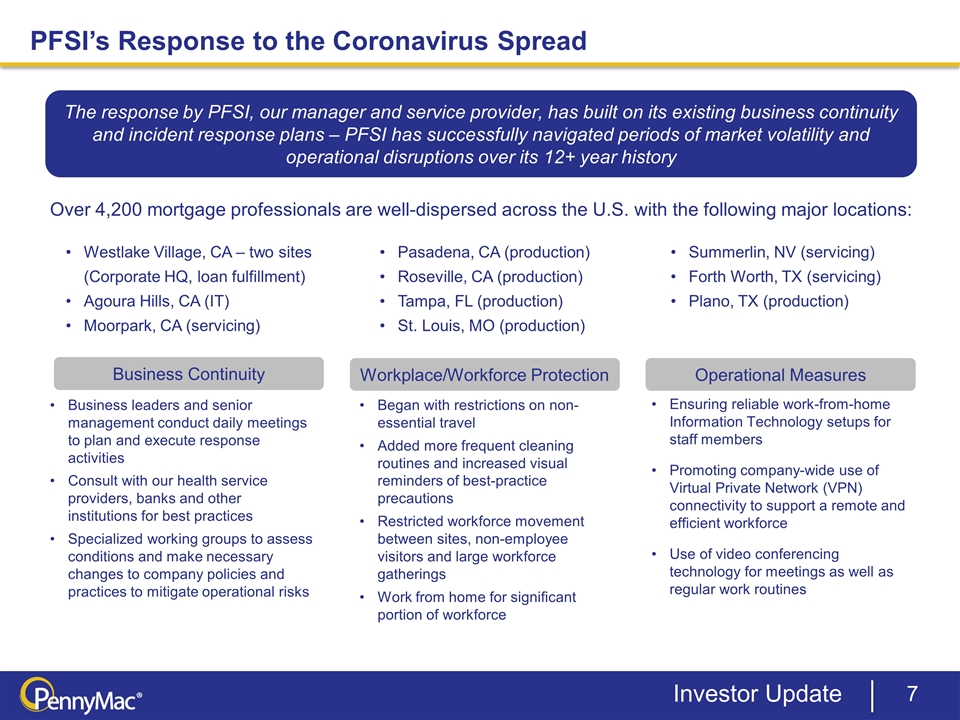
PFSI’s Response to the Coronavirus Spread Investor Update Over 4,200 mortgage professionals are well-dispersed across the U.S. with the following major locations: Westlake Village, CA – two sites (Corporate HQ, loan fulfillment) Agoura Hills, CA (IT) Moorpark, CA (servicing) Pasadena, CA (production) Roseville, CA (production) Tampa, FL (production) St. Louis, MO (production) Summerlin, NV (servicing) Forth Worth, TX (servicing) Plano, TX (production) Business leaders and senior management conduct daily meetings to plan and execute response activities Consult with our health service providers, banks and other institutions for best practices Specialized working groups to assess conditions and make necessary changes to company policies and practices to mitigate operational risks The response by PFSI, our manager and service provider, has built on its existing business continuity and incident response plans – PFSI has successfully navigated periods of market volatility and operational disruptions over its 12+ year history Business Continuity Workplace/Workforce Protection Operational Measures Began with restrictions on non-essential travel Added more frequent cleaning routines and increased visual reminders of best-practice precautions Restricted workforce movement between sites, non-employee visitors and large workforce gatherings Work from home for significant portion of workforce Ensuring reliable work-from-home Information Technology setups for staff members Promoting company-wide use of Virtual Private Network (VPN) connectivity to support a remote and efficient workforce Use of video conferencing technology for meetings as well as regular work routines
